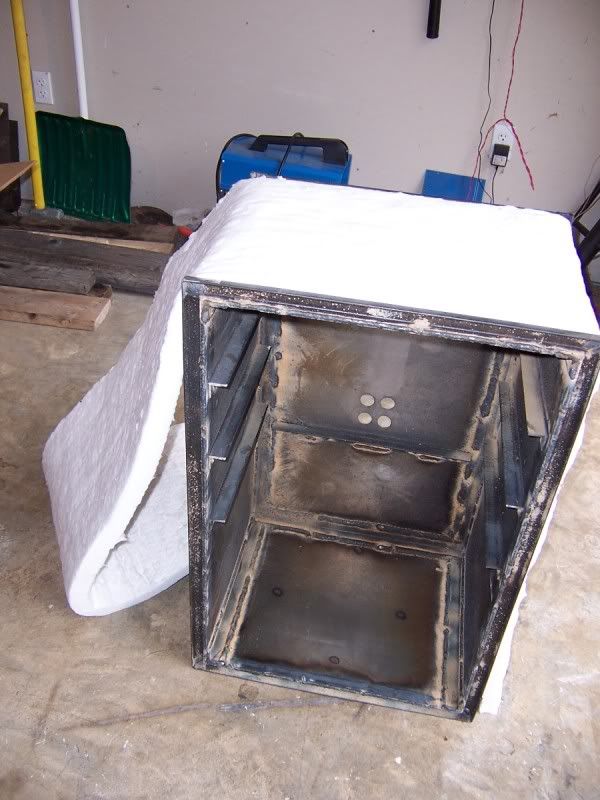Hi everyone,
I have had several requests for info on my small home built cabinets, so to answer them all I thought I would put together some info and post.
I modeled them after a backwoods smoker http://www.backwoods-smoker.com/. My Insurance guy was a rep for them and talked about insulated smokers a lot...trouble was that I couldn't part with that kind of money for one when I knew I could make one for way less. I had never seen inside a backwoods smoker when I built mine, but have since had a chance to peek inside one. I do not have a cad drawing for one, as I kind of built my first one as a prototype off of an idea that I had. Here is a graphic of how they are structured:

The theory is that the heat from the firebox rises to the top and then "reverses flow" across the meat to the smoke stack exit at the bottom of the smoking chamber (just above the water pan). When I built mine I didn't know about the raceway so I just have an open space on the side and thought that the heated air would immediately go to the top and then reverse flow...it works just the same, but I need to keep food away from the edge about an inch or two. I built mine out of a 4' X 10' sheet of 10 gauge steel...I made the dimensions so that I only used one sheet. It is about the size of a bar refrigerator, and with the cart it probably weighs 325 lbs. Here are some pics of the build.......I have built two of these so far (more to come) and the only thing I changed from rev 1 to rev 2 was the gasket design. On the second one, I turned the channel around so that I used a rope gasket instead of a tape gasket. This made it a little bit more forgiving in terms of the doors being absolutely on the same plane to seal properly.
Some of these pics are from build one and some are from build 2...so if you see any discrepancies I did streamline the process for the second one. I started with a basic rectangle shape...I already have the angle iron shelf supports welded in.

I added the back with the chimney holes drilled out. Then I added angle to the corners and welded it in. I also welded the rear edges just to be sure there was no way for smoke, humidity, water, or grease to get between the walls and into the insulation.

I added the channel to separate the walls, and then welded in some nails to ensure that the insulation stayed in place. Then I put insulation in between the walls.



Then I tacked on the outer skin and welded all around it...here you can see the chimney will be enclosed in the back wall.

For the rear, I put in a pass through for a thermo cable. The back has 2" of insulation to accomodate the chimney inside the outer skin.

Next I put framing on the front for the doors. I used gate valves for the air intake...I didn't have the ability to cut a slide as I didn't have a plasma cutter at this point. I did have welder and could put in a pipe nipple, weld around that and then thread on a gate valve...they work great, and I think they look pretty cool too.


Here I am lighting the first fire of my smoking career...I didn't even have a chimney to start it, so I had to use my mapp gas torch. I was so hopeful that my design would actually work.

Here it is with a food service steam table water pan in it...I have since built a receiver for a disposable aluminum pan so I don't have to clean it up from smoke to smoke...I just throw the pan away and get a new one. You can see the original design was a tape gasket. This pressed on the edges of the smoker which had to be perfectly flat and on the same plane to seal properly. I messed around with this more than I can tell you, so I changed the design for build #2.

Here is the first one after I got it painted

For the second one (which I gave to my brother) I pimped out the cart a bit by adding a rebar basket...I'm over 6'1" and 235 lbs and I could stand in that basket...I thought it looked pretty good too. It fit with the "industrial" smoker look. I have trailer jacks on one end so I can always level the water pan so it doesn't drain out one end of the pan.

For the second build I also added a basket for the firepan. Here it is shown with a detachable handle to move it around while it is hot.


Here is inside the second build after a seasoning fire and before the paint.

I liked the color scheme of the first one, so my brother got the same thing.

When my brother came out to visit and pick up his new smoker, we put them to the test and both cooked some great food…side by side. I was really proud to give him such a great gift.

I have had several requests for info on my small home built cabinets, so to answer them all I thought I would put together some info and post.
I modeled them after a backwoods smoker http://www.backwoods-smoker.com/. My Insurance guy was a rep for them and talked about insulated smokers a lot...trouble was that I couldn't part with that kind of money for one when I knew I could make one for way less. I had never seen inside a backwoods smoker when I built mine, but have since had a chance to peek inside one. I do not have a cad drawing for one, as I kind of built my first one as a prototype off of an idea that I had. Here is a graphic of how they are structured:

The theory is that the heat from the firebox rises to the top and then "reverses flow" across the meat to the smoke stack exit at the bottom of the smoking chamber (just above the water pan). When I built mine I didn't know about the raceway so I just have an open space on the side and thought that the heated air would immediately go to the top and then reverse flow...it works just the same, but I need to keep food away from the edge about an inch or two. I built mine out of a 4' X 10' sheet of 10 gauge steel...I made the dimensions so that I only used one sheet. It is about the size of a bar refrigerator, and with the cart it probably weighs 325 lbs. Here are some pics of the build.......I have built two of these so far (more to come) and the only thing I changed from rev 1 to rev 2 was the gasket design. On the second one, I turned the channel around so that I used a rope gasket instead of a tape gasket. This made it a little bit more forgiving in terms of the doors being absolutely on the same plane to seal properly.
Some of these pics are from build one and some are from build 2...so if you see any discrepancies I did streamline the process for the second one. I started with a basic rectangle shape...I already have the angle iron shelf supports welded in.

I added the back with the chimney holes drilled out. Then I added angle to the corners and welded it in. I also welded the rear edges just to be sure there was no way for smoke, humidity, water, or grease to get between the walls and into the insulation.

I added the channel to separate the walls, and then welded in some nails to ensure that the insulation stayed in place. Then I put insulation in between the walls.



Then I tacked on the outer skin and welded all around it...here you can see the chimney will be enclosed in the back wall.

For the rear, I put in a pass through for a thermo cable. The back has 2" of insulation to accomodate the chimney inside the outer skin.

Next I put framing on the front for the doors. I used gate valves for the air intake...I didn't have the ability to cut a slide as I didn't have a plasma cutter at this point. I did have welder and could put in a pipe nipple, weld around that and then thread on a gate valve...they work great, and I think they look pretty cool too.


Here I am lighting the first fire of my smoking career...I didn't even have a chimney to start it, so I had to use my mapp gas torch. I was so hopeful that my design would actually work.

Here it is with a food service steam table water pan in it...I have since built a receiver for a disposable aluminum pan so I don't have to clean it up from smoke to smoke...I just throw the pan away and get a new one. You can see the original design was a tape gasket. This pressed on the edges of the smoker which had to be perfectly flat and on the same plane to seal properly. I messed around with this more than I can tell you, so I changed the design for build #2.

Here is the first one after I got it painted

For the second one (which I gave to my brother) I pimped out the cart a bit by adding a rebar basket...I'm over 6'1" and 235 lbs and I could stand in that basket...I thought it looked pretty good too. It fit with the "industrial" smoker look. I have trailer jacks on one end so I can always level the water pan so it doesn't drain out one end of the pan.

For the second build I also added a basket for the firepan. Here it is shown with a detachable handle to move it around while it is hot.


Here is inside the second build after a seasoning fire and before the paint.

I liked the color scheme of the first one, so my brother got the same thing.

When my brother came out to visit and pick up his new smoker, we put them to the test and both cooked some great food…side by side. I was really proud to give him such a great gift.



















 Have you posted the recipes for the legs and fatties??
Have you posted the recipes for the legs and fatties??





Comment